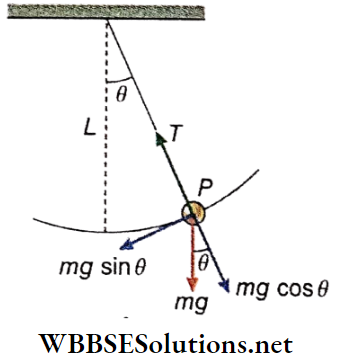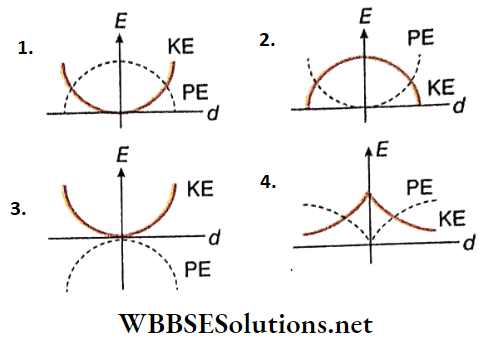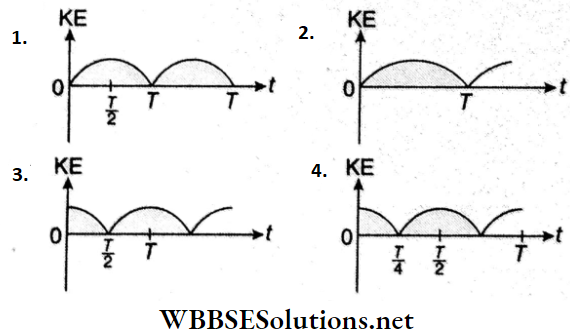Simple Harmonic Motion Short Answer Type Questions
Question 1. The kinetic energy (K) and potential energy (V) of a particle performing a simple harmonic motion are such that, always
- K> V
- K< V
- K= V
- K+V= constant
Answer: The option 4 is correct.
Question 2. A particle situated in a homogeneous medium performs a simple harmonic oscillation of amplitude 3 cm and frequency 25 Hz. The velocity of the waves generated is 300 cm • s-1. Find the equation of the waves propagating in the positive direction of the x-axis.
Answer:
If Amplitude, A = 3 cm; frequency, n = 25 Hz; velocity, V = 300 cm · s-1
So, angular velocity, ω = 2πn = 2π X 25 = 50π
Hence, the equation of the wave along the positive x-axis,
x = \(A \sin \omega\left(t-\frac{x}{V}\right) \quad \text { or, } x=3 \sin 50 \pi\left(t-\frac{x}{300}\right) \mathrm{cm}\)
Question 3. Show that the equation x = acos²ωt represents a simple harmonic motion. Find the
- Amplitude,
- Time period and
- Position of equilibrium of the particle.
Answer:
x = \(a \cos ^2 \omega t=\frac{1}{2} a \cdot 2 \cos ^2 \omega t=\frac{1}{2} a(\cos 2 \omega t+1)\)
= \(\frac{a}{2}+\frac{a}{2} \cos 2 \omega t\)
The term \(\frac{a}{2} \cos 2 \omega t\) indicates simple harmonie motion
Amplitude = \(\frac{1}{2} a\)
Here, \(\omega^{\prime}=2 \omega\)
So, time period, \(T=\frac{2 \pi}{\omega^{\prime}}=\frac{2 \pi}{2 \omega}=\frac{\pi}{\omega}\)
For the term \(\frac{a}{2} \cos 2 \omega t\) of simple harmonic motion acceleration \(=-\omega^{\prime 2} x^{\prime}=-4 \omega^2 x^{\prime} \quad\left[because \omega^{\prime}=2 \omega\right]\)
At the equilibrium position, acceleration =0
∴ 0 = \(-4 \omega^2 x^{\prime} \quad \text { or, } x^{\prime}=0\)
As, \(x=\frac{a}{2}+\frac{a}{2} \cos 2 \omega t=\frac{a}{2}+x^{\prime}\) so, equilibrium position is,
x = \(\frac{a}{2}+0 \quad \text { or, } x=\frac{a}{2}\)

Question 4. Can a simple pendulum experiment be performed inside a satellite?
Answer:
- All objects are weightless inside an artificial satellite. Hence, the effective value of the acceleration due to gravity is zero.
- However, the working principle of a simple pendulum depends upon gravity.
- Therefore, a simple pendulum experiment cannot be performed inside a satellite.
Question 5. The Earth revolves around the sun. Is it an example of a simple harmonic motion? Explain.
Answer:
In the case of the motion of the earth (if we consider the earth’s orbit to be spherical), its acceleration is directed towards a particular point (sun). But this motion is not linear. Also, the value of acceleration does not vary pro¬portionally with the distance of the earth from the sun. Hence, the earth’s revolution around the sun is not an example of simple harmonic motion.
WBCHSE Class 11 SHM Short Answer Questions
Question 6. A particle executes a simple harmonic motion of amplitude A. The distance from the mean position where its kinetic energy is equal to its potential energy is
- 0.81 A
- 0.71A
- 0.61A
- 0.51A
Answer:
⇒ \(\frac{1}{2} m \omega^2\left(A^2-x^2\right)=\frac{1}{2} m \omega^2 x^2 \text { or, } A^2=2 x^2\)
or, x = 0.71 A
The option 2 is correct.
Question 7. Show that the equation x = asinωt + bcosωt represents a simple harmonic motion.
Answer:
x = asinωt+ bcosωt
or, \(\frac{d x}{d t}=a \omega \cos \omega t-b \omega \sin \omega t\)
or, \(\frac{d^2 x}{d t^2}=-a \omega^2 \sin \omega t-b \omega^2 \cos \omega t\)
or, \(\frac{d^2 x}{d t^2}=-\omega^2(a \sin \omega t+b \cos \omega t)\)
or, \(\frac{d^2 x}{d t^2}=-\omega^2 x \quad or, \frac{d^2 x}{d t^2}+\omega^2 x=0\)
This is the differential equation of simple harmonic motion.
Question 8. The equation of motion of a particle executing SHM is x = asin(cot+ \(\frac{\pi}{6}\)) with time period T. Find the time interval at which the velocity is half of its maximum value.
Answer:
Displacement of the particle executing simple harmonic motion,
x = \(a \sin \left(\omega t+\frac{\pi}{6}\right)\)
∴ Velocity, v = \(\frac{d x}{d t}=a \omega \cos \left(\omega t+\frac{\pi}{6}\right)\)
∴ Maximum velocity, \(v_{\max }=a \omega\)
Here, \(v=\frac{v_{\max }}{2}\)
or, \(a \omega \cos \left(\omega t+\frac{\pi}{6}\right)=\frac{a \omega}{2}\)
or, \(\cos \left(\omega t+\frac{\pi}{6}\right)=\frac{1}{2}=\cos \frac{\pi}{3}\)
∴ \(\omega t+\frac{\pi}{6}=\frac{\pi}{3} or, \frac{2 \pi}{T} \cdot t=\frac{\pi}{6}\left[because \omega=\frac{2 \pi}{T}\right]\)
∴ \(\frac{t}{T}=\frac{1}{12}\)
So, after 1/12 of the time period, the velocity of the particle is half of its maximum value.
| Class 11 Physics | Class 12 Maths | Class 11 Chemistry |
| NEET Foundation | Class 12 Physics | NEET Physics |
Question 9. If the displacement and the restoring force acting on a particle executing simple harmonic motion are x and F respectively, then P = -kx. Here the negative sign on the right-hand side indicates that
- The restoring force is directed toward the equilibrium position
- The restoring force is directly proportional to the displacement
- The force constant is always negative
- The restoring force is always negative
Answer:
The negative sign indicates restoring force directed opposite to the displacement of the particle and towards the equilibrium position.
The option 1 is correct.
Question 10. Show that in SHM the ratio of acceleration and displacement of a particle always remains unchanged.
Answer:
For particle of mass m executing SHM, F = -kx [ k = constant] or, ma = -kx
or, \(\frac{a}{x}=-\frac{k}{m}\) [a = acceleration]
∴ \(\frac{a}{x}=\text { constant }\)
Simple Harmonic Motion Short Answer Type WBCHSE
Question 11. A simple pendulum of length swings in a vertical plane. The tension of the string when it makes an angle θ with the vertical and the bob of mass m moves with a speed v is (g is the gravitational acceleration)
- mv²/L
- mgcosθ+mv²/L
- mgcosθ-mv²/L
- mgcosθ

Answer:
At point P, the resultant of the tension in the string (T) and the component of weight (mgcosθ) provide the necessary centripetal force for the circular motion of the bob,
i.e., \(T-m g \cos \theta=\frac{m v^2}{L} \text { or, } T=m g \cos \theta+\frac{m v^2}{L}\)
The option 2 is correct.
Question 12. A particle vibrating simply harmonically has an acceleration of 16 cm · s-2 when it is at a distance of 4 cm from the mean position. Its time period is
- 1s
- 2.572s
- 3.142s
- 6.028s
Answer:
Acceleration of particle executing SHM at a distance x from the equilibrium position, a = ω²x
∴ Angular velocity, \(\omega=\sqrt{\frac{a}{x}}=\sqrt{\frac{16}{4}}=2 \mathrm{rad} / \mathrm{s}\)
Therefore, time period T = \(\frac{2 \pi}{\omega}=\frac{2 \pi}{2}=\pi=3.142 \mathrm{~s}\)
The option 3 is correct.
Question 13. The velocity of a particle executing a simple harmonic motion is 13 m • s-1 when its distance from the equilibrium position (Q) is 3 m and its velocity is 12 m • s-1 when it is 5 m away from Q. The frequency of tire simple harmonic motion is
- \(\frac{5 \pi}{8}\)
- \(\frac{5}{8 \pi}\)
- \(\frac{8 \pi}{5}\)
- \(\frac{8}{5 \pi}\)
Answer:
We know that, v = \(\omega \sqrt{A^2}-x^2\)
13 = \(\omega \sqrt{A^2-3^2}\)
and 12 = \(\omega \sqrt{A^2-5^2}\)
Solving (1) and (2), we get, ω = \(\frac{5}{8 \pi}\)
The option 2 is correct
Question 14. In case of a simple harmonic motion, if the velocity is plotted along the X-axis and the displacement (from the equilibrium position) is plotted along the Y-axis, the resultant curve happens to be an ellipse with the ratio \(\frac{\text { major axis (along } X \text { ) }}{\text { minor axis (along } Y \text { ) }}=20 \pi\). What is the frequency of the simple harmonic motion?
- 100Hz
- 20Hz
- 10Hz
- 1/10Hz
Answer:
Let x = A sinωt
∴ \(\frac{d x}{d t}=A \omega \cos \omega t\) or, v = \(A \omega \cos \omega t\)
∴ \(\frac{x^2}{A^2}+\frac{v^2}{(A \omega)^2}=\sin ^2 \omega t+\cos ^2 \omega t=1\)
According to the question, \(\frac{\text { major axis (along } X)}{\text { minor axis (along } Y \text { ) }}=20 \pi\)
or, \(\frac{2 A \omega}{2 A}=20 \pi \text { or, } \omega=20 \pi\)
or, \(2 \pi f=20 \pi \text { or, } f=10 \mathrm{~Hz}\)
The option 3 is correct.
Class 11 Physics SHM Short Answer Practice
Question 15. A particle moves with simple harmonic motion in a straight line. In the first τs, after starting from rest it travels a distance a, and in the next τs, it travels 2a, in the same direction, then
- The amplitude of motion is 3 a
- The time period of oscillations is 8τ
- The amplitude of motion is 4 a
- The time period of oscillations is 6τ
Answer:
The particle starts from rest at one end of its motion
i.e., from x = A.
So, x = Acosωt.
In the first τs, as it travels a distance, its position is
x = \(A-a=A \cos \omega \tau \quad \text { or, } a=A(1-\cos \omega \tau)\)
Similarly, \(A-(a+2 a)=A \cos 2 \omega \tau\)
or, \(3 a=A(1-\cos 2 \omega \tau)=A \cdot 2 \sin ^2 \omega \tau\)
or, \(3 A(1-\cos \omega \tau)=A\left(2-2 \cos ^2 \omega \tau\right)\)
or, \(2-2 \cos ^2 \omega \tau=3-3 \cos \omega \tau\)
or, \((\cos \omega \tau-1)(2 \cos \omega \tau-1)=0\)
Now if \(\cos \omega \tau-1=0\), then \(\cos \omega \tau=1=\cos 0\) or, \(\omega=0\)
This is unphysical.
∴ \(2 \cos \omega \tau-1=0 \text { or, } \cos \omega \tau=\frac{1}{2}=\cos \frac{\pi}{3}\)
or, \(\omega=\frac{\pi}{3 \tau}\)
So, \(T=\frac{2 \pi}{\omega}=6 \tau\)
Then, \(a=A\left(1-\frac{1}{2}\right)\) or, A = 2a
The option 4 is correct.
Question 16. For a simple pendulum, a graph is plotted between its kinetic energy (KE) and potential energy (PE) against its displacement d. Which one of the following represents these correctly? (Graphs are schematic and not drawn to scale)

Answer: The option 2 is correct.
Question 17. A pendulum made of a uniform wire of cross-sectional area A has a time period T. When an additional mass M is added to its bob, the time period changes to TM. If the Young’s modulus of the material of the wire is Y, then \(\frac{1}{Y}\) is equal to (g = gravitational acceleration)
- \(\left[\left(\frac{T_M}{T}\right)^2-1\right] \frac{A}{M g}\)
- \(\left[\left(\frac{I_M}{T}\right)^2-1\right] \frac{M g}{A}\)
- \(\left[1-\left(\frac{T_M}{T}\right)^2\right] \frac{A}{M g}\)
- \(\left[1-\left(\frac{T}{T_M}\right)^2\right] \frac{A}{M g}\)
Answer:
In the first case, the time period of the simple pendulum,
T = \(2 \pi \sqrt{\frac{L}{g}}\)
When an additional mass M is added to its bob, the new time period, \(T_M=2 \pi \sqrt{\frac{L+l}{g}}\)
and \(\frac{M g}{A}\) = longitudinal stress
Then, \(\frac{1}{Y}=\frac{\text { strain }}{\text { stress }}=\left[\left(\frac{T_M}{T}\right)^2-1\right] \frac{A}{M g}\)
The option 1 is correct.
WBCHSE Physics Short Answer Questions on SHM
Question 18. A particle performs simple harmonic motion with amplitude A. Its speed is trebled at the instant that it is at a distance \(\frac{2A}{3}\) from the equilibrium position. The new amplitude of the motion is
- \(\frac{A}{3} \sqrt{41}\)
- 3 A
- \(A \sqrt{3}\)
- \(\frac{7 A}{3}\)
Answer:
Velocity of particle executing SHM, \(\nu=\omega \sqrt{A^2-x^2}\)
[ω = angular velocity of a particle]
At \(x=\frac{2 A}{3}, v^{\prime}=\omega \sqrt{A^2-\frac{4 A^2}{9}}=\omega \sqrt{\frac{5 A^2}{9}}\)
At x = \(\frac{2 A}{3}\), the speed of the particle is trebled.
∴ \(\omega \sqrt{A^{\prime 2}-x^2}=3 \omega \sqrt{\frac{5 A^2}{9}}\)
[A’ = new amplitude]
or, \(A^{\prime 2}-x^2=5 A^2\)
or, \(A^{\prime 2}=5 A^2+x^2=5 A^2+\left(\frac{2 A}{3}\right)^2=5 A^2+\frac{4 A^2}{9}\)
= \(\frac{49 A^2}{9}\)
∴ A’ = 7A/3
The option 4 is correct.
Question 19. A particle is executing simple harmonic motion with a time period T. At time t = 0, it is at its position of equilibrium. The kinetic energy-time graph of the particle will look like:

Answer:
Expression for the kinetic energy of a particle executing SHM,
KE = \(\frac{1}{2} m \omega^2 A^2 \cos ^2 \omega t=(\mathrm{KE})_{\max } \cos ^2 \omega t\)

The option 4 is correct.
Question 20. A silver atom in a solid oscillates in simple harmonic motion in some direction with a frequency of 1012 s-1. What is the force constant of the bonds connecting one atom with the other? (Mole wt. of Silver =108 and Avogadro number =6.02 x 1023 g · mol-1)
- 2.2 N/m
- 5.5 N/m
- 6.4 N/m
- 7.1 N/m
Answer:
Two atoms with their bond executing SHM be compared to the vibration of a spring.
Now, T = \(2 \pi \sqrt{\frac{m}{k}}\) [k is spring constant]
Thus, \(f=\frac{1}{T}\)
or, \(f=\frac{1}{2 \pi} \sqrt{\frac{k}{m}} \quad or, 10^{12}=\frac{1}{2 \pi} \sqrt{\frac{k}{m}}\)
or, k = \(4 \pi^2 m \times 10^{24}=\frac{4 \times \pi^2 \times 108 \times 10^{-3}}{6.02 \times 10^{23}} \times 10^{24}\)
= \(7.08 \mathrm{~N} / \mathrm{m} \approx 7.1 \mathrm{~N} / \mathrm{m}\)
The option 4 is correct.
